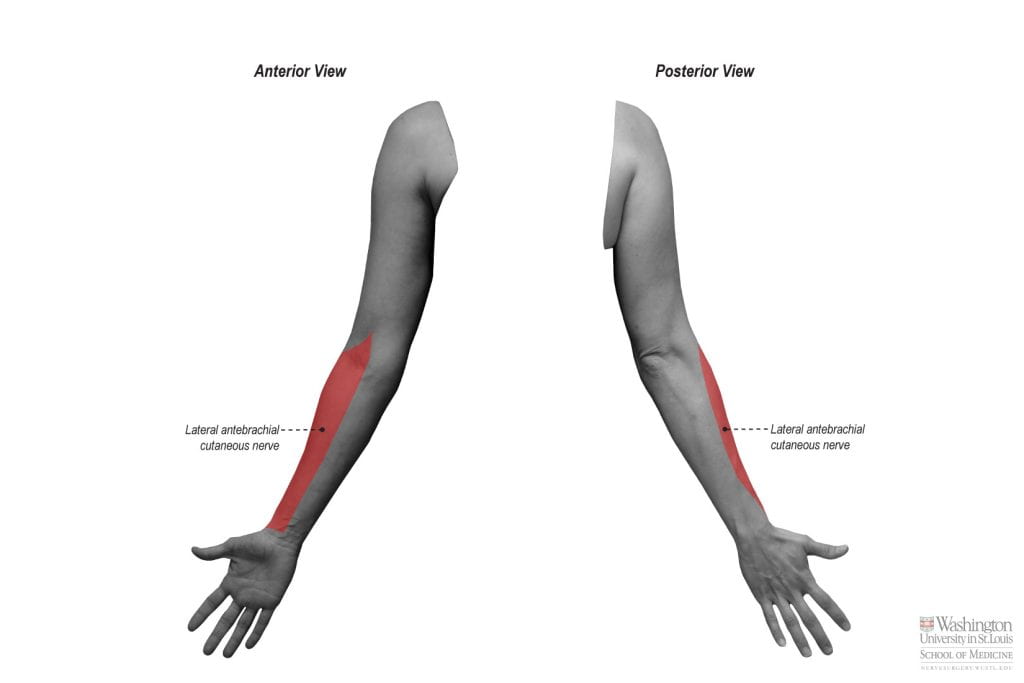Key Points:
- Patient complaints of pain at the dorso-radial/lateral forearm/wrist area require examination of this nerve especially after previous surgery/injury to his area.
Sensory Innervation:
- Provides sensation to the lateral cutaneous aspect of the forearm.
- Originates from roots C5, C6, C7 and branches from the musculocutaneous nerve.
Nerve Grafting: This nerve is expendable to use as a nerve graft and sensory examination of this nerve will confirm its utility.

EXAMINATION
Sensory examination includes testing the lateral aspect of the forearm innervated by the antebrachial cutaneous nerve.
Sensory Examination:
- Ask patients to draw area of diminished sensation/numbness on a body diagram.
- Test the skin along the lateral aspect of the forearm/wrist for reduced/absent sensation by use of light touch or other sensory examination modalities.
Clinical Relevance:
- Provides sensation to the lateral cutaneous aspect of the forearm through the musculocutaneous nerve.
- Injury to the musculocutaneous nerve from which LABC branches from will result in a sensory deficit of the LABC nerve territory.
- The LABC nerve can be injured during surgical procedures that involve where the nerve courses and innervates the dorso-radial/lateral forearm/wrist. A surgical procedure that includes a risk of injuring this nerve is De Quervain’s release.
- The sensory territory of the LABC nerve can overlap the superficial radial sensory nerve territory 25% of the time. The remainder of the time includes some varying degree of subtle overlap.
- During examination, differentiating an injury to the LABC nerve versus the superficial radial sensory nerve can be challenging due to the sensory territories overlapping within the distal forearm and wrist.
- Eliciting a Tinel’s sign over the individual nerves as they course superficially can help distinguish between them:
- Lateral Antebrachial Cutaneous Nerve: A Tinel’s test over the antecubital fossa just medial to the brachioradialis muscle.
- Radial Sensory Nerve: A Tinel’s test over the area where the radial sensory nerve courses superficially between the tendons of the brachioradialis and extensor carpi radialis longus muscles.
- A diagnostic block to either nerve to see if this alleviates symptoms may also be helpful in determining further interventions.
- The LABC nerve is expendable and can be used for nerve graft material as it innervates a non-critical sensory territory. This nerve can be harvested with the arm-level tourniquet inflated as an advantage over other expendable sensory nerves.
Adjacent Sensory Distribution:
PROXIMAL – Posterior brachial cutaneous nerve.
MEDIAL/ANTERIOR – Medial antebrachial cutaneous nerve.
MEDIAL/POSTERIOR – Posterior antebrachial cutaneous nerve.
DISTAL/ANTERIOR – Palmar branch of the median nerve.
DISTAL/POSTERIOR – Superficial radial nerve. The superficial radial sensory nerve and LABC nerve sensory territories overlap significantly. They completely overlap 25% of the population while the other 75% exists some varying degree of subtle overlap.
Relevant Anatomy:
Innervation:
- Roots: C5, C6, C7.
- Nerve: Musculocutaneous nerve.
- Sensory Territory: Lateral aspect of the forearm.
- Innervation Route: C5, C6, C7→ musculocutaneous nerve → lateral antebrachial cutaneous nerve.
Course: The musculocutaneous nerve becomes the lateral antebrachial cutaneous nerve when the brachialis nerve branch forks off to innervate the brachialis muscle. The lateral antebrachial cutaneous nerve continues distally to innervate the lateral aspect of the forearm. It is located in close proximity to the cephalic vein within the proximal forearm.